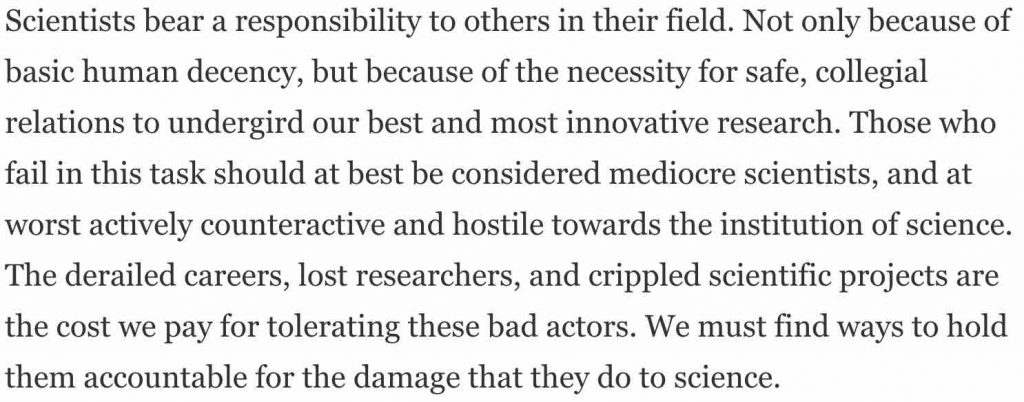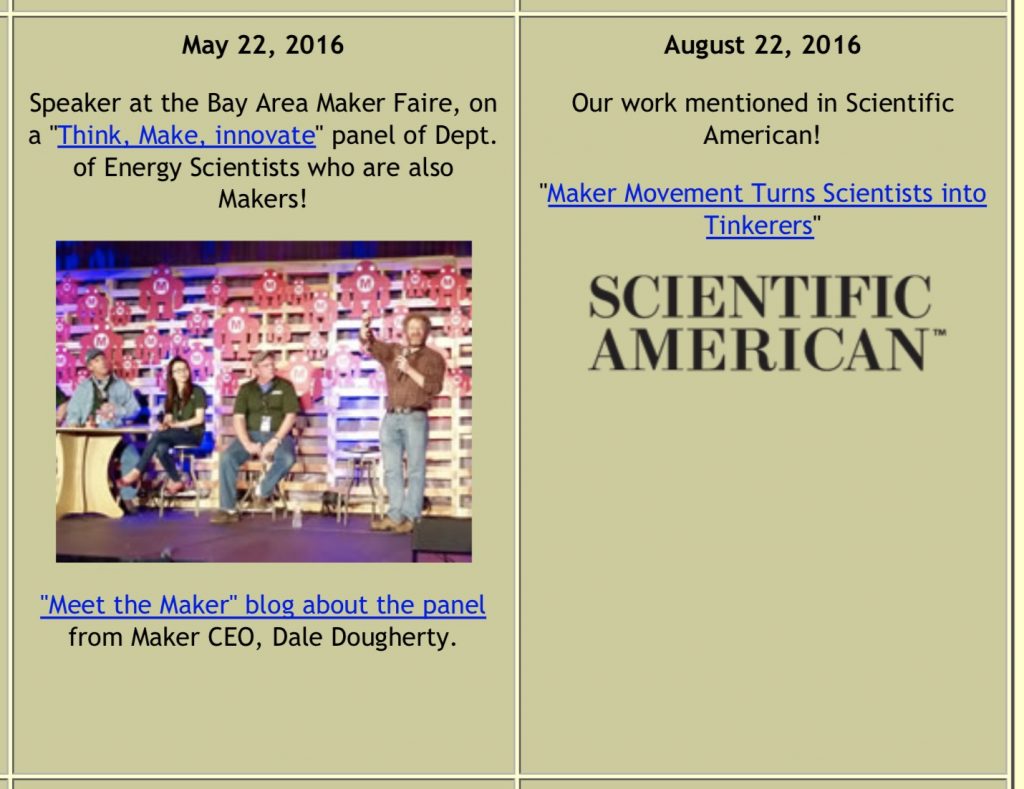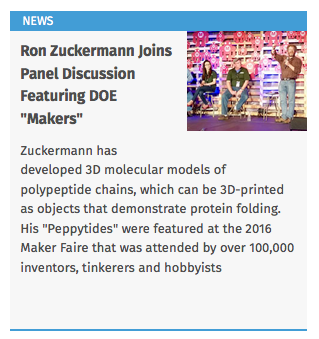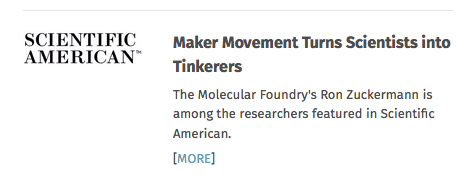Mathematically, I find RZ’s comments on my “lack of scientific promise” and “no significant contribution” to be very odd. From his homepage (http://ronznet.com) where he tabulates all his career accomplishments and other goodies and calls them “What’s Hot!”, we can have a fact-check. Since the time of my first paper (July 2013) to mid-2017 (when he refused to remove the YouTube video of his NIH talk), 9 out of 26 items in the webpage are from my work alone. That is 34.6% – which means more than one-third of the things worth mentioning as “hot” or accomplishments by such a “luminary scientist” with such a huge team (including researchers and administrative assistants), including publications, news media, award, and external news matters he deems important, are from my work only in that webpage. One in every three accomplishments, even 3 years after I had left (I have screenshots of the website in case it changes).
Moreover, considering RZ’s entire career-wide accomplishments (2003 – mid-2017) from the same website, 9 out of 46 items are for my work. 20%. One in every five accomplishments that RZ thinks are worth bragging about in his entire portion of career documented online, comes from work that is 100% mine that was done over just three years versus his 25+ year long career.
Let’s look at the video items in his website achievements list. Out of 10 videos (spanning 2008-present), the latest 2 are mine – one giving a brief about my models, and another is the talk he gave at NIH about my work. 20%. If you think he doesn’t pay that much attention to these videos and are just listing them, consider the fight he put up for reinstating the YouTube video as a proof of his intention to take over my work.
I have a feeling that he didn’t mention all these percentages when he wrote job letters for me in the past, though he claims that it was a “strongly positive letter” of which I got no calls. Plus there were those meeting sessions to convince me to quit science and take up art.
He submitted a very lame last minute nomination for the UCSF Sandler fellowship.
He refused to write letters for me if I did not hand over the patent for my work to him. One such example of refusal was an application for UC Berkeley’s Miller Fellowship. Berkeley Lab says that his reason to refuse to write me a letter for Miller Fellowship was that I am not as good as “Carl Sagan”. I am serious.
Lab also says he refused because he is “ethically obligated to write recommendations that are consistent with his assessment of scientific promise.”
Sure, my scientific promise definitely sucks.
Two years before that, RZ gave another excuse for this decision – that he was not a professor but a scientist. He wrote to me,
“I am not eligible to be a sponsor since I am not a professor. I was also told that candidates typically have many high impact papers. So at the moment my take on this is that we are not in a good position to apply for this.” (I have the email, dt Sep 8, 2014, 5:54 PM).
Told by who I do not know. And note his use of “we” to imply himself, shifting ambiguity around as needed.
The above response changed to the ethical obligation excuse when I pointed out that Miller fellowship does accept nominations from scientists. From the website,
“The Miller Institute for Basic Research in Science invites department chairs, faculty advisors, professors and research scientists at institutions around the world to submit online nominations for Miller Research Fellowships in the basic sciences.” [http://miller.berkeley.edu/fellowship]
The important word in his response is “sponsor”. He didn’t write me the letter because he cannot sponsor me, though he could nominate me, and that if I got the opportunity, I would go on to be a financially independent researcher. It was a déjà vu moment when I recalled that he did the same kind of thing for my IDEA Studio Scholar decision-making by rejecting it behind my back (“you were not eligible to receive funds … as an IDEA Studio Scholar because you would have had to receive the funds as an individual and the Lab could not have accepted them.”). In short, he wanted to control my research funds, and he wanted to control me. He forced me to quit after he made sure I submitted the Foundry user proposal in order to bring me to a compromising position so that I would have had to accept working under him unpaid in his new company that he was planning to form, and under his supervision through the approved Foundry user proposal (details on this later). Same pattern of control and manipulation. He was trying to control me – trying to say that if I cannot work for him, if I do not agree to work under his control, if I do not sign off the rights to my work to him, then I cannot work anywhere else within the STEM community, he wouldn’t allow it. This behavior is fulsome weird, I do not have any word for it. Moreover, this is an average, typical example of bizarre powerful male domination that is quietly tolerated in academia.
Summary of simultaneous contradictory events:
- September 8, 2014, 5:54 PM: Refused letters to me after having this application planned out since March, as a culmination of trying to convince me: “Take a career break and think”, “Your work is not science”, “Sign the patent rights off to me” and “Consider an art career”.
- September 9, 2014, 11:00 AM: Gave an invited talk in a seminar series about my work plus peptoids at University of the Pacific (flyer).
It was always the same pattern: he first lets me get in and to initiate something, then he gets in through emotional manipulation, or brute force or just by saying “am the PI”. Then he pushes me out. So then, I am out, but he is in. This reads like a Comedy of Errors game theme, but unfortunately had been very real experiences for me. He was just playing mind-games with me at some subconscious level, in the eeriest subtlest way possible.
Always the same pattern: A pattern of she-to-we-to-I by long-term, slow, invisible manipulation by using me as some sort of substitution-placeholder-catalyst.
This cycle of contradictory behavior occurred with my Director’s Award as well in 2014 – I got in, then somehow he got in, and then he tried to prevent me from being a part of that award (more or less saying: here take this money and silently go, no awards for you). And you guessed it: it happened for the patent too. The particulars of these are too big to be contained in the margin here.
Interestingly, the more fact checking I did about everything he had said to me, the more I realized that he had not been truthful.
Let’s be clear. If my models look nice in addition to being scientifically accurate, if I have artistic bent in addition to scientific, that is an added positive dimensionality of my research as a scientist. It should be a good thing. In computer science lingo, it’s a feature, not a bug. It is not something to be used as a weapon to discredit and deny me a career. RZ has a manipulative way with words and he uses it well.
Back to providing evidence. Here are some quotes about what he tells reporters and interviewers about my work behind my back.
RZ interviewed around May 2016, with Dale Dougherty, founder of MAKE, after giving a talk about it in MakerFaire 2016:
“ “Being able to imagine in three dimensions is a key thing that we need more scientists to be good at,” said Ron. What he’d like Makers, and future Makers, to understand is that at the national labs you can do cutting-edge work “on things that have never been done before.” He added that it’s “original research” and it is not beyond the reach of Makers to do.” [from: Meet Makers From the Department of Energy at Maker Faire]
This post mentioned me because they had to, because of two reasons: (1) because I had already published an article in MAKE in 2013 on how to build these models, and (2) because MAKE had earlier published a brief interview video of me in which I was the one talking about my models, not RZ. That’s evidence hard to refute. However, Dougherty didn’t reach out to me. He took RZ’s interview about my models. Plus he sat in audience while RZ gave a talk at MakerFaire about my work, a talk that I was not accepted for.
RZ then used this interview to advertise himself more elsewhere, where he then probably forgot to mention me.
Few months later, Scientific American published another of RZ’s interviews in their August 2016 article:
“Over at the Lawrence Berkeley National Laboratory, nanobiochemist Ronald Zuckermann prints flexible 3-D plastic models of peptide-like polymers to study how they fold into stable structures. The shape and dynamics of the polymer chain dictate its properties for medical use. “The understanding I have gained from the model has been invaluable in helping me design new polymers,” Zuckermann says.” [from: Maker Movement Turns Scientists into Tinkerers]
My work was all “Zuckermann” here. I am not even there in abstract form as a “team”. By then, the pretense of “team” was not necessary. I had just vanished.
Note that the word “models” has been used instead of peppytides for the first time (the aftermath of my complaint). This was RZ’s new tactic with media coverage after I complained in 2016. More examples of this behavior later.
It’s good that he got “invaluable” understanding with thinking in 3-dimension using my work – in spite of him spending 25+ years in the career prior to this particular “understanding,” 3+ years of which was spent watching me develop this work and learning from me. Good thing to know that my work and vision is useful to people out there – scientific stimulation is a good thing, isn’t it – and especially to the “luminary” ones who keep discrediting.
Here is an article that shows Scientific American values correct crediting of women in their works, A Hidden History: “Women have always played a role in science. It’s up to all of us to ensure that they’re part of the story”.
In good faith, I am assuming that Scientific American meant no harm to me and was unaware of my existence. But I do not know yet if that’s a correct assumption or whether (as RZ claims he always mentions me) they knew that it is my work and had still omitted me – as DoE and MakerFaire knowingly did for the talk at MakerFaire 2016.
In another of Scientific American article, this type of problem has been succinctly summarized. I cannot say it any better, so here it is:

The damage that RZ had done to me, I can accept as my destiny. But would the federal funders accept the accumulated damage done to all such crippled projects (and lives) nation-wide as just cheap casualties for tolerating certain precious luminaries?
And once all these articles are out there, RZ says, it is not in his role to make efforts to correct them because it is press’s fault and not his, after he had explicitly told the press to credit me in his interviews. The letter from Berkeley Lab reflects the same sentiment: “You seem to contend that Dr. Zuckermann should police news sites to ensure that you are identified on all that mention the Peppytide model. That is not his role. Furthermore, while publications serve to advance scientific careers, news articles seldom do.” The strange logic used by LBL to make it sound okay for RZ to claim my work as “Zuckermann’s Peppytides” is that news articles reporting scientific work do not advance careers. Funny comment.
From RZ’s homepage where he declared news about my work in mid-2016, we can see that he definitely thinks that it is within his role to brag about it:

The slippery “our” is there again avoiding a mention of me as the inventor. Subsequent press releases within the Molecular Foundry, bragging about the above news articles, made his name bold and square so that there is absolutely no doubt, in public eye, about who needs to be credited for the work. These blocks show the true, hidden intent of appropriation.
It’s funny that the news-about-the-news about my work knows which name to police-in and which name to police-out.
RZ behaved like it didn’t matter who got the credit and it was not a mentionable issue with respect to the grand goal of scientific advancements, but oddly every time it’s his name+face that was found in print with my work. Screenshots from Molecular Foundry’s website as evidence of this kind act:

And also:

The phrases “Zuckermann has developed …” and “His Peppytides” is very funny. But I know that the Molecular Foundry knows that I am the person behind this work. So the omission shows deep systemic problem with proper crediting at the Foundry and the Materials Sciences Division. I recommend thorough trainings for the people who put these blobs out there. They need to be aware of the repercussions of their irresponsibility.
Another interesting thing to note is that DoE and MakerFaire chose RZ (not me) to give this talk about my work in 2016. They did not even bother to contact me.
In short, my work is interesting enough to be presented in front of a wide audience by an invited speaker (and then reported about), but not if the face behind that is of a brown, south-Asian, immigrant woman’s. So probably they fixed that issue outright by putting the right kind of colorfully-luminous luminary speaker out there. I like that idea, and I like this kind of problem solving approach. Scientificfantastique!
It’s equally entertaining that MakerFaire parallelly rejected my submission for the same talk that same year, just a month prior to the event. Here’s the rejection email (dt Apr 25 2016):
Subject: Speaker Application Update: Maker Faire Bay Area 2016: [Presentation xxxxx]
“Dear Promita,
We are unable to include your presentation in Maker Faire this year.
We encourage you to keep making, and we would love to see you enjoy the festivities at Maker Faire.
Thanks for submitting your proposal.”
May I say, thank you for your “encouragement.”
It would be fun too to get the statistics and head-count on how many men vs. women presented at MakerFaire that year (and other years). I know that the company (Maker Media) was recently going through pre-bankruptcy and then through efforts of a recovery, but they should still be having the data.
To summarize: I have been separated from my work, and have been dismissed. Simultaneously, RZ got invited to present that same work. He did not contact me either. Instead, he presented it himself (May 2016), and gave interviews to people who wrote about it (Dale Dougherty blog, Scientific American), and put up news highlight blobs in his homepage and in Berkeley Lab Material Science Division’s Molecular Foundry website about this presentation/talk that clearly establishes phrases like “His Peppytides” and “Zuckermann has developed” (Aug 2016). Timewise concurrently, behind the screen, Berkeley Lab, in collaboration with RZ, was preparing to send me that response letter denying my complaint, denying my competence in science, denying me rights, and threatening me to keep quiet (which I got in Jul 2016). And meanwhile they also issued their first-ever Abusive Conduct and Bullying policy (Feb-Aug 2016). As I mentioned priorly, I had also submitted a grievance to DoE in Jul 2016, which seems to have been ignored, while RZ got validated, supported and given opportunities by DoE because he is established and is from a top institution in nation, and funded by DoE.
Needless to say, I did not bother to attend any MakerFaire event after that. I avoided ACS Annual Meetings and AAAS Annual Meetings as well. I do not have the right kind of profile, I guess. We already know who will be favored over me. And we already know who likes unfair limelight.
Because of my complaints, 2016/2017 onwards RZ started employing a new technique. He still continued using – showing or talking about or giving media interviews about – my “unscientific” model one way or another, but without naming/tagging it as “peppytides” so that the trouble-makers like me would not surface. A few examples (proofs) are:
- Nov 2017:
- “X-Ray Vision: Berkeley’s High-Speed Electrons Fuel Atomic-Scale Science”, WCSJ 2017 (World Conference of Science Journalists) – http://wcsj2017.org/x-ray-vision-berkeleys-high-speed-electrons-fuel-atomic-scale-science/
- “Life’s First Molecule Was Protein, Not RNA, New Model Suggests”, Quanta Magazine, Nov 2017, https://www.quantamagazine.org/lifes-first-molecule-was-protein-not-rna-new-model-suggests-20171102/
- Nov 2019:
- “A Game-Changing Test for Prion, Alzheimer’s, and Parkinson’s Diseases is on the Horizon,” https://newscenter.lbl.gov/2019/11/06/test-for-prions/
- “Berkeley Lab researchers develop method for detecting prion-related diseases,” https://www.dailycal.org/2019/11/08/berkeley-lab-researchers-develop-method-for-detecting-prion-related-diseases/
- “Scientists Develop Test to Identify Alzheimer’s, Parkinson’s and Prion Diseases,” https://www.beingpatient.com/peptoid-alzheimers-prion-test/
If even in 2019, this is useful to luminary people, then that is something, isn’t it.
Now that we have collected sufficiently enough pebbles in the beach, let us go analyze them in the next Part.
